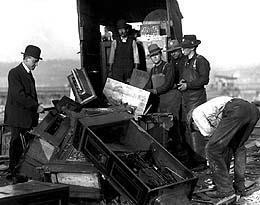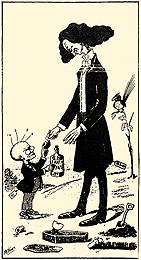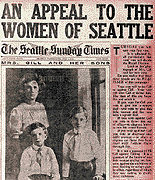By Sharon Boswell
and Lorraine McConaghy
Special to The Times
 Mayor Hiram Gill, standing on left, oversees the destruction of
slot machines during his short-lived attempt to
clean up Seattle's notorious vice district, the Tenderloin.
Mayor Hiram Gill, standing on left, oversees the destruction of
slot machines during his short-lived attempt to
clean up Seattle's notorious vice district, the Tenderloin.
Photo Credit: Webster & Stevens Collection, Museum of History and Industry
THE MARCHERS, 15,000 STRONG, WOUND THROUGH DOWNTOWN
and into Seattle's notorious red-light district,
the Tenderloin. Accompanied by a Salvation Army band, the earnest crusaders sang hymns as
they paced past saloons, brothels, gambling parlors and dance halls south of Yesler Way.
Here, according to one newspaper account, "sin, vice and crime sneak forth like human wolves
only after the sun goes down."
On this April 1905 evening, city clergy along with "white-haired grandmothers and middle-aged
matrons with their children" had left their comfortable homes to bring a message of salvation
to those who frequented Seattle's "bottomless cauldron of sin."
Even before the heady Gold Rush days, when boomtown Seattle had realized that Klondike
vice was every bit as profitable as Klondike outfitting, the city had gained a reputation as a "hot town,"
where good times could be had 24 hours a day. Yet as soon as Seattle found prosperity, respectable citizenry
wanted to change its image to a family town.
Using city hall, churches and courtrooms as their battleground,
the forces of virtue competed with the purveyors of vice for moral authority over Seattle's soul.
It took a decade before a new city emerged, changed but not entirely converted.

The Rev. Mark Matthews: Seattle's tallest preacher crusaded
against government corruption. Here, he "buried the hatchet" with politician Hiram Gill;
it didn't stay buried long.
JOINING THE MARCH ON THE TENDERLOIN IN 1905 was a man who became one of the most outspoken leaders of
social reform, the Rev. Mark Matthews of Seattle's First Presbyterian Church. The lanky parson,
a striking figure with his 6-foot-5-inch frame and mane of black hair, preached the gospel of urban
righteousness. Matthews believed that Seattle churches should lead the reform by influencing public policy
to cleanse the city.
Matthews launched his first campaign against sin by exposing what he termed the "symptoms of graftitis"
among local officials. Charging City Council members with unethical, if not criminal,
behavior, Matthews particularly targeted Council President Hiram Gill, a lawyer who defended
the interests of Tenderloin saloonkeepers and brothel owners. In a packed public meeting, Matthews
dramatically accused Gill of condoning vice, even leaving a city meeting to bail a notorious gambling
operator out of jail.
Despite extensive publicity from The Times and other newspapers, Matthews'
charges had limited impact, and in 1906 Gill handily won re-election.
But Matthews did spearhead the passage of a City Charter amendment allowing citizens
to recall officials -- a measure that would soon have a profound effect on Gill and Seattle.
 At left, Hiram Gill. Photo credit: Seattle Times.
At left, Hiram Gill. Photo credit: Seattle Times.
IN 1910 GILL RAN FOR MAYOR ON A PLATFORM CALLING for a district that confined vice to one section
of the city. Urged on by progressive reformers, previous mayors had tried to tame
the Tenderloin by degrees, first outlawing gambling, then imposing strict tavern hours,
and finally shutting down the district altogether. But their efforts had merely diffused
the problem, driving illicit activities undercover and the city's 400-plus prostitutes to
boarding houses and hotels all over town. Gill argued that vice was a natural
-- and lucrative -- part of the human condition. His strategy for regulation gained
him enough support for election.
 At right, The Seattle Times fought for restrictions on vice, yet supported the questionable Mayor Hiram Gill and
his police chief, Charles Wappenstein.
At right, The Seattle Times fought for restrictions on vice, yet supported the questionable Mayor Hiram Gill and
his police chief, Charles Wappenstein.
YET HORRIFIED REFORMERS SOON FOUND THAT THE RESTRICTED DISTRICT kept expanding.
Many blamed Gill's police chief, Charles Wappenstein, who claimed to be tough on
crime but was rumored to overlook illegal activities in return for kickbacks.
Cynics dubbed the Tenderloin "Wappyville."
When Gill refused to fire the chief, moral reformers joined with good-government
advocates to recall the mayor. A Public Welfare League formed in October 1910
circulated petitions, collecting enough signatures to force a recall election
the following February. Bolstered by the votes of more than 22,000 women
just granted suffrage, the forces of virtue threw Gill out of office and
launched new efforts to stamp out vice and corruption.
Matthews again led the charge, secretly hiring the renowned William
Burns Detective Agency for an undercover investigation. Burns found enough
evidence to convict Seattle's police chief of bribery and extortion, and send him to prison.
Others who supported Wappy, including outspoken Times publisher Alden Blethen,
also became targets of investigation, indicted by the grand jury but never convicted.
Reformers took other extreme measures to clean up the city. Most
outrageous was the Purity Squad, a Police Department unit that patrolled
the city looking for illicit activity. Critics charged overzealous officers
with rousting innocent single women from their hotel rooms or arresting
married couples found downtown after dark.
By 1914, reformers believed they were well on their way to making Seattle
a virtuous family town. They declared Seattle had changed. Perhaps so;
but in that same year the resilient Gill ran once more for mayor.
Penitent, Gill claimed he now supported temperance and honest government.
He won election, and soon the Tenderloin was running full tilt again.
Historians Sharon Boswell and Lorraine McConaghy teach at local universities
and do research, writing and oral history. Original newspaper graphics courtesy of the Seattle Public Library.